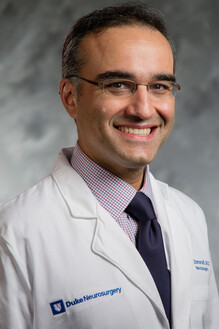5 Things to Know About Acoustic Neuroma Surgery

Neurosurgeon Ali Zomorodi, MD, works with team members during a skull base tumor surgery.
Acoustic neuromas (also known as vestibular schwannomas) are a noncancerous type of skull base tumor, which grow just below the brain. More specifically, acoustic neuromas form on the vestibulocochlear nerve that controls balance and hearing. While removing these tumors can completely cure symptoms, their location is highly sensitive and requires an expert surgical approach. Here, Duke Health specialists discuss what you should expect if you need acoustic neuroma surgery.
1. Acoustic Neuroma Surgery Can Be Risky
Removing acoustic neuromas is challenging because of their location. “The nerves that help move the eyes, the nerves that allow you to feel your face, move your face, chew food, taste food, hear -- all of those are packed into a very small space at the base of the skull” said Duke neurosurgeon Ali Zomorodi, MD. “To treat a tumor in this area, you need to be able to work very delicately and precisely around some very sensitive neurological and vascular structures.”
2. When to Choose Acoustic Neuroma Surgery
While you may be eager to be rid of your acoustic neuroma, your age, the tumor’s size and location, as well as the severity of your symptoms will help determine whether surgery is your best option. You may be better off waiting and watching.
3. There Are Three Main Approaches to Acoustic Neuroma Surgery
There are three main approaches to surgically removing acoustic neuromas that grow within the skull base (doctors call this lateral skull base tumor surgery). The surgical approach that is recommended for you will depend on the size of your tumor, its location within the skull base, and the status of your hearing.
- The middle fossa approach accesses the tumor from above the ear. This option is best for smaller tumors, and it is used to try to preserve hearing.
- The retrosigmoid approach accesses the tumor from behind the ear. This option can be used for tumors of any size, and it may also help preserve hearing.
- The translabyrinthine approach accesses the tumor through the temporal bone behind the ear. It is considered when tumors are very large or when significant hearing loss has already occurred because it leaves little or no chance of hearing preservation.
4. What to Expect Before, During, and After Acoustic Neuroma Surgery
Before surgery, your first stop is a pre-operative check where your vitals will be monitored. You’ll also speak with an anesthesiologist and your surgeon. Assuming everything looks good, you’ll be transferred to the operating room. The surgery usually lasts between six and eight hours.
Your Duke Health surgical team will include a neurosurgeon and a neurotologist, which is a specialized ear, nose, and throat (ENT) surgeon who treats complex ear and hearing issues and neurological-related inner ear concerns. The role of the neurotologist is to surgically expose the tumor and assist in its removal, according Duke’s Calhoun Cunningham, MD. The neurosurgeon’s role is to remove the tumor, dissecting it “away from important nerve structures as well as from the brain itself,” Dr. Cunningham said. Finally, the ENT surgeon/neurotologist closes everything back up.
After surgery, you’ll recover in a special neurosurgery intensive care unit (ICU) before moving to a step-down unit, usually the next day. Most people return home after about five days in the hospital, but full recovery takes up to eight weeks.
5. Choosing a Hospital for Acoustic Neuroma Surgery
If you need acoustic neuroma surgery, keep these considerations in mind, said Drs. Zomorodi and Cunningham. Find a center that routinely performs complex skull base tumor surgery. Also, look for a specialized team approach to care, meaning you’ll have access to an ENT, a neurosurgeon, and other specialists, including radiation oncologists, neuroradiologists, audiologists, physical therapists, and speech pathologists.
“If we do everything we can and do a great job, the patient can be healed,” said Dr. Zomorodi. “They don't have to worry about this tumor anymore. They can carry on with their lives, and this will become a distant memory. Our goal is to minimize the impact that the tumor and its treatment will have on their quality of life.”




